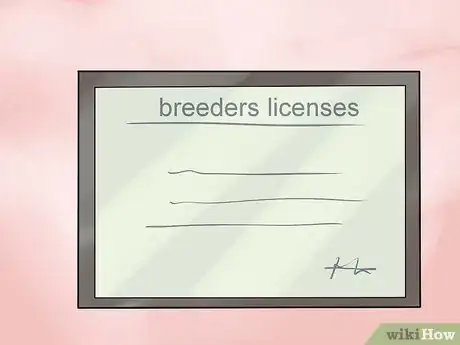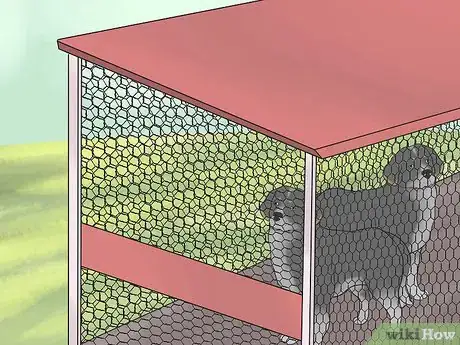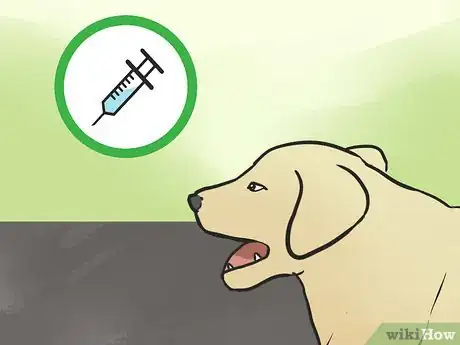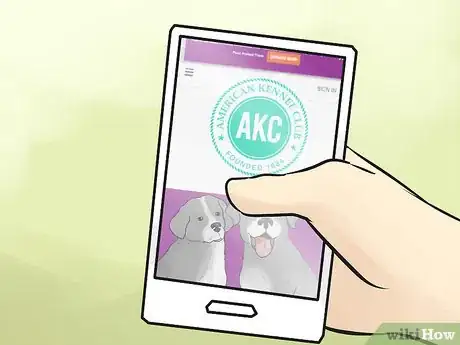This article was co-authored by Tom Robertson and by wikiHow staff writer, Sophia Latorre. Tom Robertson is a Dog Breeding Specialist and the Owner of Prize Poodles and Doodles. With over 20 years of experience, he specializes in breeding doodles. Tom has also received additional educational training in dog grooming, boarding, and training.
There are 8 references cited in this article, which can be found at the bottom of the page.
wikiHow marks an article as reader-approved once it receives enough positive feedback. In this case, 100% of readers who voted found the article helpful, earning it our reader-approved status.
This article has been viewed 34,823 times.
If you have a passion and love for dogs, you already possess the first requirement for becoming a dog breeder! Now you’ll need to figure out which kind of dog you want to breed and learn as much about that breed as possible. You’ll also need a suitable space or facility for breeding dogs, as well as necessary supplies like housing, food, water, bedding, toys, and grooming supplies. Expect to invest a lot of time and money into creating your new business. Fortunately, there’s also much joy to be found in becoming a dog breeder.
Steps
Getting Started
-
1Decide what breed you will specialize in. Reputable dog breeders don’t breed a variety of dogs. They specialize in one, or maybe two, breeds of dogs. You may have a breed in mind that you particularly love, or you may need to spend some time considering which breed would be best for you.
- Account for their personalities and temperaments as well as the space you’ll need to house the breed depending on their size.
- Also consider their needs, including veterinary care in addition to food and exercise requirements.
-
2Research your chosen breed extensively.[1] You need to know as much as you can about the dogs you’re going to breed. Research their medical history and find out the strengths and weaknesses of the breed. Determine what kind of personalities these dogs generally have, be aware of any medical conditions they are prone to, and research the best practices for breeding them.Advertisement
-
3Create a business plan. Find out the rules and regulations in your area for breeding dogs. Look into the market for the breed you have chosen and determine how much it will cost to purchase the male and female dogs you need to start your business. Account for other financial expenses, such as property or kennels, food, bedding, toys, grooming, and veterinary care.[2]
-
4Be prepared to dedicate a lot of time to this endeavor. You will need to spend time feeding, exercising, and playing with your dogs as well as taking them to the veterinarian. Cleaning up the dog kennels and yard is also a time-consuming but necessary task.[3]
-
5Expect not to make much money. Unfortunately, if you’re breeding dogs the right way, there’s not a ton of money to be made. This is because you will be paying extensive veterinary bills and providing food, toys, bedding, and other essentials for all your dogs and pups. You’ll need a bit of money up front to purchase the dogs you intend to breed as well as the supplies they’ll need.[4]
-
6Choose a trusted veterinarian. While you want your vet’s office to be in a convenient location, you also want to make sure you have the best doctors for your dogs. Research and visit several veterinarians in your area before choosing which one you will trust to care for your dogs and pups. Ask about their background, education, and experience with the kind of dog you intend to breed.[5]
- Ask your veterinarian about health insurance for your dogs and puppies.
Setting up the Business
-
1Acquire any necessary permits or licenses. Depending on where you live, you may need a permit or a kennel license, or you may need to register your company. Contact your local government to determine what the rules are in regards to dog breeding. Be sure to follow the regulations and keep track of any paperwork that proves you have complied.[6]
-
2Choose registered dogs. It’s incredibly important that you choose healthy, purebred dogs to start your breeding business. Research the breeder or organization you are planning to purchase your dogs from.[7] Ensure the animals have been medically cleared and that you receive copies of all their veterinary and registration paperwork.[8]
- Dogs that have been certified by the American Kennel Club (if you live in the U.S.) are preferable.
-
3Provide housing for your dogs. If you’re starting with only one litter, you may choose to keep the dogs in your home. In that case, you might want to install baby gates around a certain area or dedicate a room in your home to the dogs. If you are undertaking a larger breeding business, you may want to build kennels for your dogs.[9] [10]
- Your dogs will need shelter from the elements in a space that sustains a comfortable temperature as well as safe and comfortable housing for sleeping and nursing.
-
4Ensure your dogs have space to exercise. Dogs, especially puppies, often have a lot of energy. They will need free space to exercise, play, explore, and roam around. Ensure any areas dedicated to your dogs are securely fenced to prevent them from escaping. Grass or soil should also be provided in lieu of concrete or asphalt.[11]
- If you live in a big city or don’t have a lot of space on your property, you may need to consider renting or buying a new space for your dog breeding business.
-
5Keep the area clean and safe. To maintain your dogs’ space, you’ll need to clean up dog waste frequently and replace worn out bedding and toys.[12] Inspect the property for potential dangers like holes under fences, toxic plants or substances, and sharp objects. Ensure the kennels or crates are in good condition and don’t present any hazards to the dogs, such as bars spaced so that a dog’s paw or head could become stuck.[13]
- Ensure you have adequate ventilation and lighting, too.
-
6Acquire all the necessary supplies. Dog breeders need tons of supplies to keep their dogs and pups happy and healthy, including high-quality adult and puppy dog food, a source of water, and dishes to feed and provide water for your dogs. You’ll also need bedding, a variety of toys, and grooming supplies such as nail clippers and dog shampoo.[14]
- Don’t forget about puppy pads, pooper-scoopers, kennel disinfectant, and paper towels, too.
-
7Keep your books up to date. You’ll need to maintain a record of expenses and profits associated with your dog breeding business. Keep all receipts from purchases such as dog food, dishes, toys, bedding, crates, or kennels. You should also keep receipts from all your visits with the veterinarian. Keep track of all dog sales and create invoices or receipts for these transactions as well.[15]
Being a Responsible Breeder
-
1Familiarize yourself with the best practices for breeding.[16] Females should not be bred every year, and they should never be bred before they reach 2 years of age, regardless of their breed. Once a female reaches 2 years of age, you can breed her, but she needs to be allowed to rest in between litters to recover fully from the trauma of birth and being separated from her puppies.[17]
- If you want to maintain a steady stream of income by having puppies continually, you’ll need to have several females.
-
2Breed the dogs using best practices. Once you’ve chosen a pair of registered dogs and had them examined by your veterinarian and registered, you can breed them.[18] Wait until the female is in heat and ovulating, then provide both dogs with a private and calm space to mate. You should supervise the breeding in case anything goes awry.
-
3Line up responsible buyers for the puppies before their birth. Reputable dog breeders rarely need to advertise that they have puppies for sale because they find responsible owners for the dogs before the mother has even given birth. Find buyers for your puppies while the mother is pregnant by reaching out to veterinarians and dog trainers in your area, attending dog events, and by posting in forums and on message boards.[19]
- Buyers should be met and vetted before you release puppies into their care.
- Puppies cannot be separated from their mother before the age of 8 weeks.
-
4Be honest about your dogs and any issues they have. If one of your dogs develops a medical condition or has another problem, you need to be honest about these issues. Let potential buyers know up front what challenges they can expect to face due to a medical condition or other problem.[20]
- Hiding medical problems or other issues can create a bad reputation for your dogs and your business, so always be honest and upfront.
-
5Ensure all your dogs get the proper veterinary care. It’s incredibly important that every dog you have receives regular veterinary care from a licensed veterinarian. This includes vaccinations and booster shots, check-ups, and emergency care. Puppies should also undergo genetic testing and get dewormed in addition to receiving shots.[21]
- Also, you should always ensure that anyone who purchases one of your puppies will get them spayed or neutered.
Networking
-
1Join local clubs. Joining local dog clubs can help you meet other people in the industry. It can also connect you with potential clients. Do an Internet search or ask your veterinarian if they know of any clubs in your area.[22]
- If you live in the U.S., consider joining the American Kennel Club, a reputable organization devoted to dog breeding that can provide you with tons of information and resources.
-
2Attend events in your area. Keep an eye out for dog events in your area, such as dog shows or dog sports events. Attending these events can help you meet other breeders as well as clients. Check local message boards or forums dedicated to dogs or do an Internet search to find events near you.[23]
-
3Get to know other breeders. Do an Internet search for other breeders in your area. Contact them and ask to visit their kennels or meet up. You can discuss challenges you face and share information about trusted vets or breeding tips.[24]
- If you breed a different kind of dog than other breeders in your area, they may even agree to refer customers to you.
-
4Set up a website. Setting up a website can help you promote your business and sell your puppies when the time comes. There are many options for creating free websites, and you can learn how to do it yourself, or ask a tech-savvy friend to help. Be sure to include your location, the kind of dogs you breed, pictures of your space and of the dogs and puppies, and any other pertinent information.[25]
-
5Utilize social media. You may want to create social media pages, like a Facebook or Twitter account, specifically for your business. You can then promote your business via social media by posting information and pictures about your dogs and puppies. Also, join other groups or follow other dog breeders online to stay in the loop regarding the industry.[26]
References
- ↑ Tom Robertson. Dog Breeding Specialist. Expert Interview. 5 April 2022.
- ↑ https://www.profitableventure.com/starting-a-dog-breeding-business/
- ↑ https://www.thekennelclub.org.uk/breeding/
- ↑ https://breedingbusiness.com/5-steps-that-will-make-you-become-successful-dog-breeder/
- ↑ https://www.profitableventure.com/starting-a-dog-breeding-business/
- ↑ https://topdogtips.com/how-to-start-a-dog-breeding-business/
- ↑ Tom Robertson. Dog Breeding Specialist. Expert Interview. 5 April 2022.
- ↑ https://topdogtips.com/how-to-start-a-dog-breeding-business/
- ↑ https://breedingbusiness.com/5-steps-that-will-make-you-become-successful-dog-breeder/
- ↑ Tom Robertson. Dog Breeding Specialist. Expert Interview. 5 April 2022.
- ↑ https://www.cga.ct.gov/2013/rpt/2013-R-0309.htm
- ↑ Tom Robertson. Dog Breeding Specialist. Expert Interview. 5 April 2022.
- ↑ https://www.cga.ct.gov/2013/rpt/2013-R-0309.htm
- ↑ https://breedingbusiness.com/5-steps-that-will-make-you-become-successful-dog-breeder/
- ↑ https://breedingbusiness.com/5-steps-that-will-make-you-become-successful-dog-breeder/
- ↑ Tom Robertson. Dog Breeding Specialist. Expert Interview. 5 April 2022.
- ↑ http://www.akc.org/dog-breeders/responsible-breeding/
- ↑ Tom Robertson. Dog Breeding Specialist. Expert Interview. 5 April 2022.
- ↑ http://www.akc.org/dog-breeders/responsible-breeding/
- ↑ http://www.akc.org/dog-breeders/responsible-breeding/
- ↑ http://www.akc.org/dog-breeders/responsible-breeding/
- ↑ https://breedingbusiness.com/5-steps-that-will-make-you-become-successful-dog-breeder/
- ↑ https://breedingbusiness.com/5-steps-that-will-make-you-become-successful-dog-breeder/
- ↑ http://www.professorshouse.com/becoming-a-dog-breeder/
- ↑ https://breedingbusiness.com/5-steps-that-will-make-you-become-successful-dog-breeder/
- ↑ https://breedingbusiness.com/5-steps-that-will-make-you-become-successful-dog-breeder/
About This Article
To become a dog breeder, start by acquiring the necessary licenses and permits for your area. Then, choose a breed to specialize in, and buy registered, purebred dogs to breed. If you're going to start with 1 litter, you may be able to raise the dogs in your home. Otherwise, you'll need to build kennels for your dogs. Keep in mind that you'll need to pay for food, bedding, toys, and veterinary costs, so make sure you have some start-up money. For tips on how to be a responsible dog breeder, scroll down!





















































































